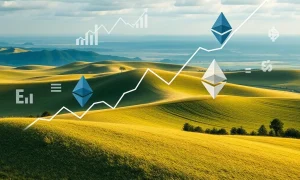The financial world recently experienced a significant jolt. Unexpected inflation data has completely upended previous predictions. Many market participants had anticipated substantial Fed rate cuts throughout the year. However, this new information paints a very different picture. The Federal Reserve’s path forward now appears far less clear. This surprising development carries wide-ranging implications for investors, businesses, and everyday consumers alike.
The Unexpected Inflation Surge and Its Impact on Fed Rate Cuts
Recent inflation reports delivered a stark reality check. Consumer Price Index (CPI) figures, for example, showed a persistent upward trend. This contradicted widespread forecasts for a cooling economy. Economists and analysts had largely expected inflation to moderate more quickly. However, core inflation metrics, which exclude volatile food and energy prices, also remained stubbornly high. This indicated broad-based price pressures across the economy.
Several factors contributed to this unexpected surge. For instance, strong consumer demand continues to play a role. A robust job market has also kept wages elevated. Supply chain issues, though easing, still contribute to some price increases. Furthermore, geopolitical events can introduce volatility into commodity markets. These combined elements created a perfect storm, pushing inflation higher than anticipated.
Market Repercussions: Why Fed Rate Cuts Seem Distant
Financial markets reacted swiftly to the inflation news. Stock indices initially saw declines. Bond yields, conversely, surged as investors adjusted their expectations. The U.S. dollar strengthened against other major currencies. This market volatility reflected a fundamental shift in sentiment. Traders quickly repriced the probability of future Fed rate cuts.
Before the data release, derivatives markets had factored in multiple rate reductions. Now, the outlook has changed dramatically. Many analysts predict fewer cuts, or even none, for the remainder of the year. Some even suggest the possibility of further rate hikes if inflation persists. This shift has significant consequences for borrowing costs. Mortgages, car loans, and business credit could all become more expensive. Consequently, economic growth might face headwinds.
The table below illustrates the shift in market expectations for Fed rate cuts:
| Period | Prior Expectation (Cuts) | Current Expectation (Cuts) | Impact |
|---|---|---|---|
| Early 2024 | 3-4 cuts | 1-2 cuts | Significant reduction in expected easing |
| Mid-2024 | Likely cuts | Uncertainty, potential for no cuts | Increased volatility, higher yields |
| Late 2024 | Further cuts | Highly data-dependent, potential for hikes | Cautious outlook, risk of tightening |
The Federal Reserve’s Deliberate Stance on Fed Rate Cuts
The Federal Reserve maintains a dual mandate. They aim for maximum employment and price stability. Current inflation levels remain above their 2% target. Therefore, the Fed prioritizes bringing inflation down. Chairman Jerome Powell has consistently emphasized a data-dependent approach. The central bank needs clear evidence that inflation is sustainably moving towards its target before considering any policy changes.
Recent statements from Fed officials reinforce this cautious stance. They indicate a willingness to keep interest rates higher for longer. This strategy aims to ensure inflation does not re-accelerate. Aggressive Fed rate cuts now appear unlikely. The Fed wants to avoid prematurely easing monetary policy. Such a move could undo progress made against inflation. Their primary goal remains achieving price stability, even if it means prolonged higher rates.
Broader Economic Implications and the Outlook for Fed Rate Cuts
The implications of persistent inflation and fewer Fed rate cuts are far-reaching. Consumers will likely feel the pinch of higher prices for longer. Their purchasing power could diminish. Savings accounts might not keep pace with inflation. For businesses, higher borrowing costs can impact investment decisions. This could slow down expansion plans and hiring. Sectors sensitive to interest rates, like real estate, face particular challenges.
The housing market, for example, may experience continued cooling. Higher mortgage rates make homeownership less affordable. This can dampen demand and potentially impact property values. Globally, the U.S. economic situation influences other nations. A stronger dollar and higher U.S. rates can create headwinds for emerging markets. Ultimately, the path of inflation will dictate the Fed’s next moves. The economy faces a period of continued adjustment.
Navigating Uncertainty: Investment Outlook Amidst Delayed Fed Rate Cuts
Investors must adapt to this evolving economic landscape. The prospect of delayed Fed rate cuts requires careful portfolio adjustments. Traditional fixed-income investments, like bonds, become more attractive with higher yields. However, bond prices can fall when rates rise. Equity markets may experience increased volatility. Companies with strong balance sheets and consistent earnings might perform better. Defensive sectors could also see increased interest.
Diversification remains a crucial strategy. Spreading investments across different asset classes helps mitigate risk. Consider reviewing your investment goals and risk tolerance. Professional financial advice can also provide valuable guidance. Staying informed about economic indicators is vital. Pay close attention to inflation data, employment reports, and Fed communications. These will offer clues about future monetary policy. The investment environment demands vigilance and adaptability.
In conclusion, the recent inflation shock has fundamentally altered expectations for Fed rate cuts. This unexpected development presents challenges for the economy and financial markets. The Federal Reserve remains committed to its inflation fight. Their patient, data-dependent approach means higher interest rates could persist. Consequently, consumers and businesses must prepare for a more restrictive monetary environment. Investors, meanwhile, need to adjust their strategies. The economic path ahead requires careful navigation. Continuous monitoring of key economic data will be essential for understanding future trends and the timing of any eventual rate adjustments.
Frequently Asked Questions (FAQs)
Q1: What caused the recent inflation shock?
The recent inflation shock stemmed from a combination of factors. Strong consumer demand, a robust job market, and elevated wages contributed significantly. Persistent supply chain issues also played a role. Furthermore, geopolitical events can impact commodity prices, adding to inflationary pressures. These elements together pushed inflation higher than anticipated by many economists.
Q2: How do delayed Fed rate cuts impact the average consumer?
Delayed Fed rate cuts mean higher borrowing costs for consumers. Mortgage rates, car loan rates, and credit card interest rates may remain elevated or even increase. This reduces purchasing power and makes big-ticket purchases more expensive. It can also impact savings if interest rates on deposits do not keep pace with inflation.
Q3: What is the Federal Reserve’s primary goal regarding inflation?
The Federal Reserve’s primary goal regarding inflation is to achieve price stability. This means bringing inflation down to its target rate of 2% over the long run. They use monetary policy tools, like interest rates, to influence economic activity and control price increases. The Fed aims to avoid both excessively high inflation and deflation.
Q4: How should investors react to the news of delayed Fed rate cuts?
Investors should consider reviewing their portfolios and strategies. Delayed Fed rate cuts suggest a “higher for longer” interest rate environment. This can impact different asset classes differently. Diversification across various investments is crucial. Focusing on companies with strong fundamentals and monitoring economic data closely are also recommended. Consulting a financial advisor can provide tailored guidance.
Q5: Will the Fed eventually cut rates, and what would trigger it?
The Federal Reserve will eventually cut rates when they are confident that inflation is sustainably moving towards their 2% target. A consistent decline in key inflation metrics, such as CPI and PCE, would be a primary trigger. Evidence of a significant weakening in the labor market or a broader economic slowdown could also prompt rate cuts. The Fed emphasizes a data-dependent approach for all future policy decisions.
























